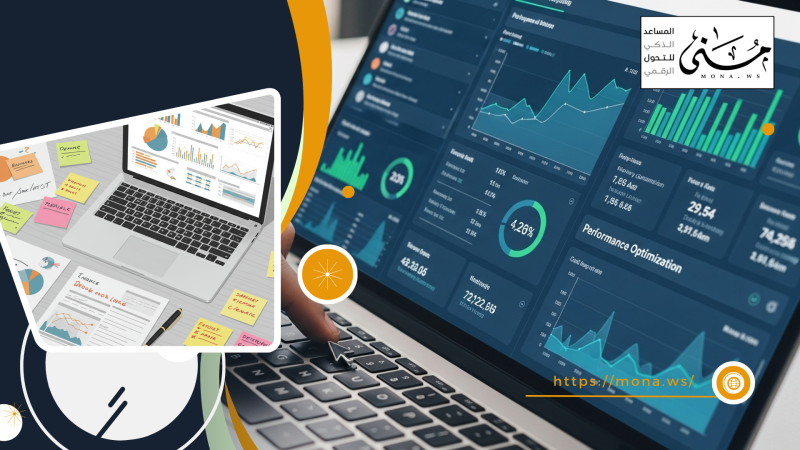From paper records to analyzable data
Have you ever wondered how many corporate decisions are made based on "intuition" rather than data?
In many organizations, paper records still dominate archives and offices, weakening the ability to analyze and leverage information to drive business. While companies talk about digital transformation, the most important question remains: How do we transform silent documents into speaking data that helps us make smarter decisions?
Moving from paper-based records management to advanced analytical databases is no longer a postponed option; it is the foundation for sustainability and effectiveness in the information age. Every saved document and every archived correspondence can be a building block in building an analytical vision that enables organizations to predict trends, improve performance, and reduce risks .
In this article, we take you on a journey from stacked paper shelves to interactive dashboards, revealing how smart tools like DocSuite ECM can... Business intelligence technologies are set to revolutionize the way we manage records and make decisions .
Problems of paper records in the corporate environment
Despite the long tradition of using paper records in organizations, this traditional approach to information management has now become an obstacle to efficiency and transparency. By their very nature, paper records lack flexibility, scalability, and analytical capabilities, and pose numerous challenges, including :
Difficulty of access and search
Accessing a specific document among thousands of papers requires a painstaking process that begins with identifying its physical storage location, proceeding to manually flipping through the files, and finally locating the required copy—if one exists. This difficulty increases as archives grow in size and there is no precise indexing system based on clear criteria such as chronological, subject, or sequential classification. In a dynamic business environment where decisions are made quickly, delayed access to a document can lead to workflow disruption, missed investment opportunities, or even legal harm to the organization when official documents are needed at a specific time as part of an audit or legal dispute .
Limited security and possibility of loss or damage
Paper records, by their physical nature, are sensitive to environmental conditions such as heat, humidity, fire, and insects. The damage of a single document could mean the loss of vital, irreplaceable information. Documents are also susceptible to loss during transit or manual handling, especially when multiple people have authorized access. Furthermore, securing records requires secure cabinets, drawers, and private rooms, as well as constant human oversight. However, it remains difficult to track who has accessed a particular document or when, making it difficult to detect irregularities or information leaks .
Impossibility of statistical analysis or tracking
Data stored within paper documents remains "locked" and cannot be used analytically unless it is manually entered into a digital system, a time-consuming process that increases the risk of human error. These documents cannot be used for quantitative analysis, performance indicators, or forecasting business trends. For example, it is extremely difficult to analyze recurring complaint patterns or track order processing times if data is scattered across disparate paper reports. This shortcoming makes it difficult for decision makers to formulate strategic directions based on actual and reliable data .
high operating costs
Managing paper records requires significant financial and human resources. Organizations need to allocate physical space for document storage, specialized furniture such as filing cabinets and drawers, and paper supplies such as filing files and archiving boxes. They also need staff dedicated to organizing, cataloging, and updating these records, and responding to retrieval requests. This is in addition to the indirect costs associated with reprinting, loss resulting from lost documents, and disruption to workflow due to slow access. In large organizations, these costs can amount to alarming proportions of the operating budget .
Poor integration with digital operations
In an era where electronic systems are integrating to provide a comprehensive picture of the organization, paper records represent a real bottleneck. When information is stored in physical files, it is impossible to directly link them to systems such as human resources management systems (HRMS) , project tracking systems, or procurement databases. This disconnect prevents the creation of automated workflows and hinders the ability to track transactions in real time. It also weakens senior management's ability to accurately monitor performance or conduct effective internal reviews, threatening the organization's efficiency and ability to adapt to market changes .
Digital Archiving as a Bridge to Transformation
Have you ever imagined that the piles of papers in your organization's archives could be transformed into an intelligent decision-making resource? In an era where business is accelerating and data-driven, paper records are no longer sufficient. Transformation begins with digitizing content and organizing it within systems such as DocSuite ECM , then transforming it into analyzable data that feeds into dashboards and performance reports. It's not a technical luxury, but a strategic step toward a more informed and intelligent organization .
What is digital archiving?
Digital archiving is a systematic process of converting paper documents or unstructured files ( such as images, PDFs , or emails ) into electronic copies that can be stored and processed within a central content management system. This process is not limited to "scanning," but rather involves integrated steps that include formatting, categorizing, and linking documents to their administrative or legal context .
Digital archiving typically relies on Enterprise Content Management (ECM) systems. Which provides advanced functions such as :
- Automatically categorize documents according to their content or type .
- Organize them into logical file structures .
- Control access permissions based on employee or department role .
- Track every activity on the document (view, edit, move, delete) to enhance security and control .
Adopting digital archiving doesn't just mean getting rid of paper, but rather moving to a new corporate culture that treats documents as dynamic entities that can be analyzed, measured, and leveraged strategically .
From paper chaos to digital structuring
The difference between a paper-based and digital environment is like moving from a dark room filled with stacked boxes to a smart, illuminated control panel. In paper archiving, there is no clear sequence or direct link between documents and processes. In digital archiving, each document takes its place within a logical structure that facilitates retrieval and analysis .
Digital archiving relies on precise classification criteria, including :
- By type : Such as distinguishing contracts from invoices, or reports from meeting minutes, which facilitates search and retrieval processes .
- According to time : Documents are automatically linked to a time frame (year, month, day) to track developments or legal obligations .
- According to practical connection : The document is linked to a specific action, such as a purchase order, a customer complaint, or a response from an official body .
This organization not only improves access, but also opens the way for the creation of digital workflows and automatic integration between documents and administrative processes .
DocSuite ECM as an Application Model
DocSuite ECM is A living example of the evolution of document management platforms and the shift from traditional archiving to intelligent, interconnected content management. It is not just a file repository, but a business system that links documents to tasks, transforming them into active components of the corporate decision cycle .
Through DocSuite ECM The institution can :
- Incoming and outgoing correspondence is automatically archived and categorized by entity, subject, and content, making it quick and accurate to access later .
- Design digital approval paths based on document content and type, so that they are automatically sent to the relevant manager or department for approval or action .
- Set precise permissions that determine who can view, edit, or share documents, protecting privacy and preventing leaks .
- Automatic alerts are triggered upon any modification, suspension, or timeout, enhancing discipline and operational control .
This system enables the organization to monitor the smallest details of the document lifecycle, transforming them into an effective information source that enhances efficiency and transparency .
Benefits of digital archiving in decision support
Digital archiving not only improves document storage, but also enables organizations to build a truly tangible information environment that can be leveraged on several levels :
• Access speed
Instead of manually searching through papers, any document can be accessed within seconds via intelligent search based on keywords or classification data. This reduces response time, both internally between departments and externally when dealing with customers, suppliers, and regulatory authorities .
• Transparency
Every action taken on a document is automatically recorded (opening, editing, copying, and deleting), creating a clear digital trace that can be revisited at any time. This fosters a culture of accountability and reduces the chances of tampering or negligence .
• Compliance
When undergoing an external audit or legal review, it becomes easier to submit the required documents with full amendment and approval records, which facilitates compliance with local and international regulations and standards ( such as ISO , GDPR , etc. ).
• Prepare for analysis
When digital documents are stored in an organized, machine-readable manner, their data can be extracted and transformed into indicators and figures that feed into analytics and business intelligence tools. This data can reveal weaknesses, opportunities for improvement, or behavioral trends that have a significant impact on overall performance .
Enterprise Analytics and Business Intelligence
After reviewing the challenges associated with paper records in the previous sections, discussing how digital archiving is a critical bridge to organization and speed, and then explaining how digital records can be transformed into an analytical database, we now come to the most impactful stage : transforming data into smart decisions .
Digital archiving doesn't end with electronic file storage, and databases don't stop at organizing information in a structured manner. Rather, the true value lies in analyzing this information and extracting indicators that contribute to improving institutional performance and strategic planning . This is where corporate analytics and business intelligence tools come into play . As an essential element that enables management to have clearer vision, faster response, and deeper control over the course of work .
In this section, we move from the "document and organize" function to the "analyze and guide" phase, where digital documents become a source for monitoring trends, measuring quality, evaluating processes, and even predicting risks before they occur .
We'll explore how these tools can create a real shift in the mindset of an organization—from simply storing knowledge to creating knowledge .
From raw data to analytical insights
Data collected from digital documents is of no real use unless it is transformed into insights that are easy to read and interpret. This is where business intelligence tools come in. They allow organizations to create interactive dashboards that display real-time key performance indicators (KPIs) , enabling them to track changes and interpret patterns. Instead of reading tedious text reports or complex Excel files , managers can view a clear visualization that answers questions like: "What are the most common types of transactions?" "Where are delays occurring?" or "How does monthly performance compare to the previous quarter?" These analytics help simplify understanding the situation and quickly identify priorities .
Real-time decision support
In a world that demands immediate responses to changes, decision makers cannot rely on outdated data or manually prepared reports that arrive days later. Real-time analytics enable managers to obtain live reports that accurately depict the status of current operations. For example, an operations manager can see the number of transactions awaiting approval, the reasons for delays, and who is responsible for each stage—all in real time. This type of analytics not only supports faster decision-making but also improves decision quality because it is based on timely and reliable data .
Prediction and anticipation
is the ability to predict the future . Using historical analysis techniques and predictive models, an organization can forecast future business trends, such as peak periods in requests, increased complaints during certain seasons, or even the likelihood of recurring management errors. For example, if data shows that the number of maintenance requests increases in the last quarter of each year, management can pre-position resources, allocate tasks, and mitigate pressure to avoid congestion and service disruptions. This proactive approach transforms data from a mere record of the past into a tool for intelligent planning .
Strengthening oversight and compliance
By tracking transactions and documenting each step in the document lifecycle, an organization can accurately monitor compliance with internal procedures and external regulatory standards. Business intelligence tools enable performance comparison with established policies, identify deviations, and detect recurrence or violations, even before they become an actual problem. For example, internal audit can determine whether procedures are being completed within the specified timeframe and whether there are any late approvals or missing documents. This type of oversight enhances organizational transparency and reduces operational and legal risks .
Integrate analytics into the same system
One of the advanced features of some content management systems like DocSuite ECM is that It doesn't just store documents; it also provides advanced analytics built into the system environment. This allows users to monitor performance, extract metrics, and identify bottlenecks directly from within the system without the need to export data or use external tools. For example, an HR administrator can view a dashboard showing vacation request completion rates, or a quality manager can monitor complaint metrics and closure statuses. This integration makes analytics an integral part of the daily workflow and makes it easy for non-technical users to leverage analytics without complexity .
DocSuite ECM software application
In a government agency that relied entirely on paper records to manage correspondence and meeting minutes, management faced recurring challenges in tracking requests and responses, in addition to the difficulty of analyzing performance due to the fragmentation of information and duplication of processes. When implementing the system With DocSuite ECM , the organization began digitizing its historical archive and creating digital workflows that process each transaction based on its type and destination. Key data, such as dates, topics, and relevant departments, was automatically extracted from each document and linked to an internal analytical database. Through interactive dashboards, senior management could monitor the number of incoming requests, their completion time, and identify operational weaknesses. This transformation significantly reduced response time, improved task allocation, and uncovered administrative redundancies, enabling the organization to make accurate decisions based on real indicators rather than guesswork or speculation .
From paper to smart data, the journey of true transformation begins. Time is running out for organizations that postpone digital archiving or hesitate to transform their information into analytical and decision-making tools. Today, accurate data is the fuel, analytics is the engine, and technology is the path. Organizations that start now with simple steps—such as digitizing records and linking them to business intelligence tools—are the ones that will lead tomorrow. Start your transformation today, and don't base your decisions on guesswork while the data is at your fingertips, waiting to speak .










Comments
Add New Comment